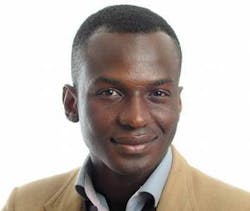Light microscopy method looks to uncover DNA transcription process
Biochemical techniques that isolate molecules in test tubes or label them in fixed cells destroy the conditions that make weak and transient interactions possible. Light microscopy can preserve those conditions, but most biomolecules are too small and interact too closely to be distinguished with the light diffraction limit of 200 nm.
But Ibrahim Cissé, assistant professor of physics at the Massachusetts Institute of Technology (MIT; Cambridge, MA)'s Department of Physics, has used a light microscopy method to solve the mystery of DNA transcription, molecule by molecule, in living cells and in real time.
For Cissé to follow transcription as it unfolds, he would have to circumvent the limitations of conventional techniques for studying biomolecules. To do this, he adapted a fluorescence imaging method called photoactivation localization microscopy (PALM), which activates fluorescent tagging proteins at random and then applies a statistical algorithm to determine the exact location of each protein with nanometer accuracy within the pixel of light. When Cissé repeats the process at high speed and volume, he can map the precise location of tagged biomolecules as they cluster at a transcription site or trace the path of a single transcription factor as it moves across the nucleus. Furthermore, by developing a temporal correlation method coupled with PALM, called tcPALM, Cissé can get direct access to the clustering dynamics for the first time.
Recently, Cissé used tcPALM to show that the transcriptional enzyme RNA Polymerase II (Pol II) clusters for just a few seconds as transcription begins. The result is surprising, given that it takes several minutes for a full RNA sequence to be synthesized. When Cissé suppressed and then reactivated transcription just before imaging, he observed Pol II clustering at unusually high concentrations. When he blocked Pol II from escaping the promoter and transcribing the DNA, the cluster of Pol II around the promoter didn't dissipate.
Cissé theorizes that Pol II clusters are coupled with both transcription initiation and promoter escape because of the way the cell uses weak and transient interactions to regulate transcription. In previous studies, scientists have shown that when Pol II interacts with the promoter region, it only ends up forming a pre-initiation complex that synthesize RNA about 1 percent of the time. Cissé thinks this inefficiency might be a good thing: Instead of every random collision of a polymerase and promoter resulting in an active gene, the cell may use clustering and other mechanisms to initiate transcription when and where it needs to.
-----
Follow us on Twitter, 'like' us on Facebook, connect with us on Google+, and join our group on LinkedIn
Subscribe now to BioOptics World magazine; it's free!

